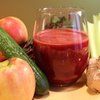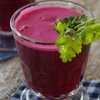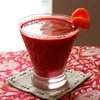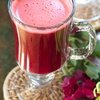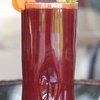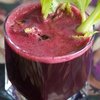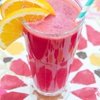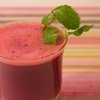Beets are a root vegetable that are often juiced for their unique taste and potential health benefits. Some people believe that juicing beets can help improve athletic performance, lower blood pressure, and reduce the risk of certain diseases.
One of the main benefits of juicing beets is that it allows you to easily consume a high amount of nutrients in a single serving. Beets are a good source of nutrients like folate, manganese, and potassium. They also contain betalains, which are pigments that give beets their characteristic red color and are thought to have antioxidant and anti-inflammatory properties.
In addition to the nutrients found in beets themselves, juicing beets also allows you to combine them with other fruits and vegetables to create nutrient-rich, flavorful juices. For example, you can add beets to a juice with apple, carrot, and ginger for a refreshing and energizing drink.
Preparing Beets for Juicing
To prepare a beet for juicing, start by washing it thoroughly under cool running water. Then, cut off the tops and roots of the beet, leaving about an inch of stem attached. Depending on the size of your juicer, you may need to cut the beet into smaller pieces to fit. If the skin of the beet is thin and tender, you can leave it on. However, if the skin is thicker or more fibrous, you may want to peel it off before juicing. This is mainly due to the more earthy flavor it may add to your juice.
Once the beet is prepared, you can juice it alone or in combination with other fruits and vegetables. Some popular ingredients to add to beet juice include apples, carrots, ginger, lemon, and spinach.
It's worth noting that beet juice can be quite potent, so you may want to start with a small amount and gradually increase the amount you consume. Additionally, beet juice can temporarily stain your skin and clothing, so be sure to wear protective clothing and use a cutting board that won't be damaged by the juice.
Can I juice the greens?
Yes, you can juice the greens of beets along with the roots. Beet greens are a good source of nutrients, including vitamins A, C, and K, as well as calcium, iron, and potassium. They have a slightly bitter, earthy flavor that can be balanced out with sweeter ingredients like apples or carrots.
To juice beet greens, simply wash and chop them as you would any other leafy green, such as spinach or kale. You can then add the beet greens to your juicer along with the beet roots and any other ingredients you're using.
Additionally, beet greens can have a strong flavor, so you may want to start with a small amount and gradually increase the amount you use in your juice.
There are a few other things you might find interesting about juicing beets:
- Beet juice can be used as a natural food coloring: The pigments that give beets their distinctive red color, called betalains, can be extracted and used as a natural food coloring. In fact, beets have been used as a natural dye for centuries, and today they are still used to color a variety of products, including beverages, candies, and cosmetics.
- Beet juice may improve athletic performance: Some research suggests that consuming beet juice before exercise can improve athletic performance, especially in endurance sports. This may be due to the high levels of nitrates found in beets, which can help widen blood vessels and increase blood flow to the muscles.
- Beet juice may have potential health benefits: In addition to its potential effects on athletic performance, beet juice has also been suggested to have other potential health benefits. Some studies have found that consuming beet juice may lower blood pressure and improve cardiovascular health. However, more research is needed to fully understand the potential health effects of beet juice.
- Beet juice can have a strong flavor: Beet juice has a distinctive, earthy flavor that some people love and others may find overpowering. If you're new to juicing beets, you may want to start with a small amount and gradually increase the amount you consume. Mixing beets with other fruits and vegetables, such as apples, carrots, and ginger, can help balance out the flavor and make the juice more palatable.
